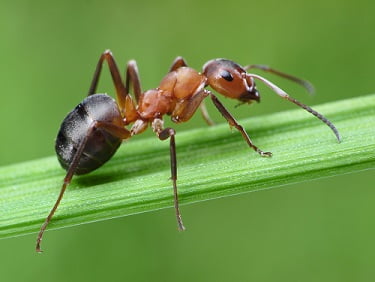
Ant Control Calgary
We offer Ant Control & Extermination Services in Calgary and our ant pest solution are very professional, diverse and affordable. We provide the best and through ant control treatments in Calgary and surrounding area. Our licensed & professional pest control technicians eliminate ants from your property successfully.
+1 (403) 708-3024Calgary Ant Control & Extermination Services
Calgary Ant Control & Extermination Services by Pestica Green Pest Control Calgary are very professional, diverse and affordable. During ant extermination process, we have to face different scenario due to different ant species and their behaviour. The following ants extermination services we provide in Calgary and surrounding areas at an affordable price to control ant's infestation permanently:
-
Residential Ant Extermination & Control: (House,
Apartment, Condo, Townhome)
-
Commercial Ant Extermination & Control: (Hotel, Motel,
Restaurant, Mall Food Court, Groceries Stores, Fast-Food Stores, Medical Clinics and Pharmacy Stores)
-
Industrial Ant Extermination & Control: (Food Factories and Warehouses)
-
Ants' Nest & Hills Extermination & Control: (Lawn
Front and Back Yard, Flower & shrub beds and acreage)
-
Ant Extermination & Control in Hospitals and Schools
-
Gardens Ant's Extermination & Control
Calgary Ant Exterminator
Ant Control & Treatment Solutions
1-800-691-2893
403-708-3024
Pestica Green
Pest Control Calgary
Calgary Professional
Ant Control
Ant Extermination Process
Ant Extermination is a process to control, remove or exterminate the ants infestation inside any structure by using environmental friendly, and effective tools and techniques. More than 100 species of ants are found in Canada. Black Carpenter, Little Black, Pavement ants, Pharaoh ants, Thatching ants, Cornfield ants and Odorous House Ants are prevalent in Calgary and nearby areas. Our pest control technicians are highly educated and experienced in ant removal in Calgary and surrouding area And we provide an affordable ant control treatment.
During the process of Ant Extermination, our company follows these steps to control the ant infestation in any types of structure:
1. Identification of Ants
2. Biology of Ants
3. Inspection of Ant infestation Level
4. Methods of Ants Control
5. Monitoring the Infestation Level After the Treatment
6. How We Remove Ants
Identification of Ants
Correct identification of the different ant species and also locating all of the ant colonies in or around the property is the first step for successful ant control program.
Ants have chewing mouthparts. Their antennae are elbowed at
the first joint.
Normally the mature males and females have wings but the
worker are wingless. The following Ants' species are found in Calgary, Alberta.
1. Black Carpenter Ants: They are
dark brown or black. The adults burrow into wood to create nests. Fine sawdust
that is expelled from the nest will indicate the location. The size of queen is
10-15 mm whereas, the size of males and workers are less than 10 mm. These
insects may enter buildings in search of food. They feed on sweet liquid. They
can bite humans.
2. Little Black Ants: Their color is jet black. They live under rocks or other
areas free of vegetation. They feed on sweet liquid and may
enter buildings in search of food. They have a mutualism with aphids because aphids provide sugar-rich honeydew as a source of food for these ants and they protect the aphids against various natural enemies.
3. Pavement Ants: Dark brown with stinger
esting: They live along sidewalks and foundations of buildings, near firewood,
stones, brick, mulch, etc. They eat dead insects, greasy food, sweets, pet food.
4. Pharaoh Ants: This species is a tiny ant, with a size of 2mm. The body color is pale yellow. lt is found in most urban centers in Canada. Pharaoh
ants prefer warmer buildings and warm areas (26-29"C) in buildings for nesting. These ants are active
year-round in heated buildings such as hospitals, office buildings, laboratory buildings, and food service
facilities. These ant feed on a variety of materials including sweets, grease, meats, fatty foods.
5.
Odorous House Ants: They have black color with the size of 2.4 to 3.3 mm. When crushed they give distinct odor.
6. Cornfield Ants: They have a reddish brown color. Their size is 2 to 2.5 mm. Winged males are small and black whereas, winged females are large honey color. They are present from Late July to mid Sep.
7. Thatching Ants: They have black or red head and black abdomen and thorax with the size of 3 to 9 mm. They are active in late summer.
These species of ants are most prevalent in Calgary, Alberta
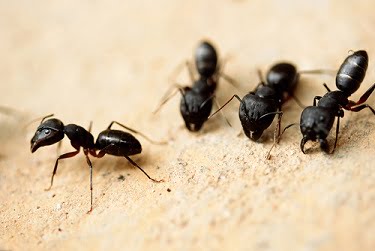
Carpenter Ants
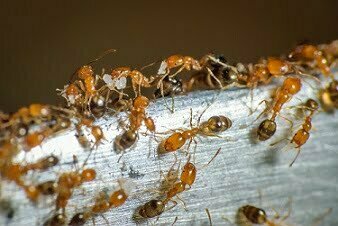
Pharaoh Ants
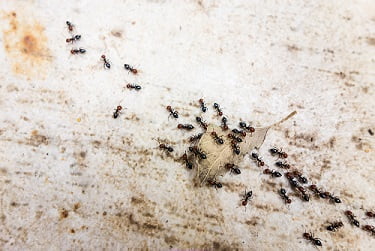
Pavement Ants
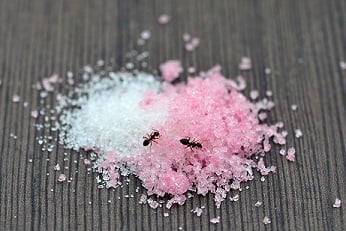
Little Black Ants
To Learn More About Ants Identification, visit ant identification.
Biology of Ants
Ants are social insects. Their colony contain three casts:
1. Worker (Sterile wingless females)
2. Winged Males
3. Queens (Females with wings)
Most mature ant colonies produce winged males and reproductive females during
early spring or summer. They will mate
in the air and then the males die. The females then find cavity and lose their
wings. The females remain there to lay their eggs. Ants undergo complete metamorphosis starting with the eggs hatching into
tiny, white, legless grubs (larvae)' The
larvae are fed with salivary secretions from the female's
stored fat cells and the breakdown of her now
useless wing muscles. After several molts, the larvae change
into soft, white, pupae that look like
motionless, white adults. When the pupae have matured they
molt into the adult stage. Queens
(reproductive females) may live for many years and produce
eggs for the subsequent broods that go on
to make the colony. worker (non-reproductive females) tend
the eggs, larvae, and pupae, forage for
food and enlarge and defend the colony Development from egg to adult takes from 38 to 45 days.
Inspection of Ants Infestation Level
Monitoring the extent of infestation is a vital step in any ant extermination program and this is called inspection of ant infestation level. We inspect the infestation level inside and also ouside structure to decide the effective treatment plan.
Inside the Structure: The
following
areas should be inspected for ant presence and behaviour:
1. Holes and cracks in and around door frames
.
2. Areas under sinks, in ceilings or in basements where there are old or new moisture stains
3. Food storage areas in kitchens especially in and around appliances and compost/recycling areas
o lunchrooms and areas where food is eaten, especially if foods are left in open containers (eg.
fruit bowls, sugar containers etc.)
4. Around bath tubs and showers.
Outside the Structure: The
following areas should be inspected for worker ant presence:
1. Behind vines, shrubs, other plants near the house
2. Cracks in the foundation, expansion joints
3. Slabs, patio blocks, bricks, boards, plant pots
o under and inside wooded columns and pillars
.
4. Outside door and window frames
5. Penetrations of the house wall by telephone wires, air-conditioning refrigerant pipes
.
6. Gaps or cracks around plumbing outlets such as outdoor taps
7. Trees that harbour colonies and provide access to houses by overhanging limbs that touch or
even scratch shingles and also inspect plants for ants tending aphids or mealybugs
8. Water/electrical metres
9. Wood in contact with soil (eg. stacked firewood, especially if it is stacked against the house), rotting tree stumps, compost areas, storm drain inspection manholes.
Methods of Ants Control
There are different methods to control ant infestation within the structure.
Physical Method To Control Ants Problem:
In this method, we encourge our clients to practicse Good Housekeeping. For example, food and food waste should be stored in containers with tight fitting lids to eliminate access
by ants.
. Living spaces, office and storage spaces should be kept as free debris as possible. Second thing, we recommend sealing the foundation cracks and space between door and frames and the structure, plumbing,
electrical and other openings into the structure with silicone caulking.
Habitat Alteration To Remove The Ants:
It is a through, long term ant management program involves correcting any conditions in and
around the structure that may be contributing to the infestation. It may be necessary to
wall penetrations and mortar masonry cracks, caulk door and window frames, repair waterleaks, trim shrubbery away from the house, move firewood stacked against the house, and
control ant tended aphids and mealybugs.
Chemical Method To Eliminate The Ants Infestation:
To conduct this method, trained and experienced Pest Control Technicians are required for the safety. There are three different options we can adopt to eliminate thd Ants infestation.
1. Bait: Baits with stomach poisons or with insect growth regulators can be used to control ants. Baits
are excellent in critical areas (e.g., computer or hospital rooms) as the insecticide is sealed
within the bait station so does not expose fragile equipment or people to the bait.
Baits or bait materials should never be stored where they can be contaminated with any other
odours especially fumes of other pesticides. Ants and other insects can detect minute amounts
of foreign or repellant chemicals.
2. Dust: Dusts can be used in wall voids and crack and crevice treatments. Dust such as Ditomaceous and Silica Gel have a drying effect on insects. Boric acid powder has a low toxicity to humans but acts as a stomach poison for ants. These dusts are effective when blown into cracks and
wall voids before they are sealed.
3. Sprays: S
prays may also be used in crack and crevice treatments. Wettable powders and
microeneapsulated spray formulations can be applied where pesticides may be absorbed into
surfaces without damage to the surface. Spot treatments can be used when necessary. Some pesticides
have ant repellant activity and force ants to spread their infestations to other parts of the structure. So hire trained Pest Control Technicians to coduct the spray treatment.
Monitoring the Infestation Level of Ants After Treatment
Monitoring the infestation level after the treatment is a very vital step in Ant Extermination Management Program. We do by interviewing or clients to get information where ants are being noticed and the extent of the infestation. From there, the ant infestation should be determined by observing ant worker movement and determining the extent of the infestation. After taht we decide that there is any need for another treatment or not.
How We Remove Ants
- Technician will start by checking the exterior and interior of your home to locate any ant’s nest and hill.
- Technician may set up and implement a program by using insects’ monitors, liquid sprays, dust and/or bait stations according to the situation and infestation level.
- During implementing ants control measures, we adopt all safety precautions
- If infestation is high and deep then we recommend a second treatment after one month of the first treatment
Calgary Ant Exterminator
Ant Control & Treatment Service
1-800-691-2893
403-708-3024
Pestica Green
Pest Control Calgary
Effective Ant Removal
Pestica Green Pest Control Has
A Privilege Of Membership With Leading
Pest Control Industry
Professional Organizations
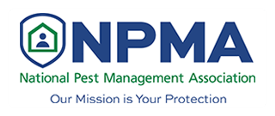
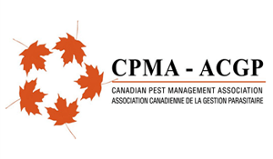
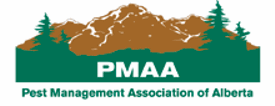
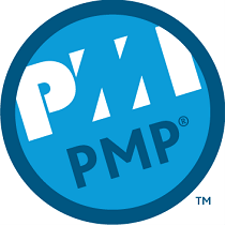


Quality, Not Quantity, Google Reviews 100%
From Our Customers
We are a top rated, 100% locally owned, operated & loved Canadian Pest Management Company in Alberta. Please review us on Google because your opinion matters for us.
To read our weekly posts about Pest Control Calgary, click on the icon.

Frequently Asked Questions
About Ants Extermination in Calgary
How long queen can live?
A queen can live as long as 10 years, while the male worker ants only live for a few weeks since they die shortly after mating, and sterile female worker ants will live a few months to several years.
What is the total population of ants in a colony?
An average colony contains 2,000 to 3,000 ants.
Where can I most likely to find carpenter ants?
They prefer damp areas and may construct their nests anywhere in properties including walls, ceilings, attics, doors, window sills, shingles and insulation.
Is there any difference between Ants’ hills and Ants’ nests?
Ant nests are underground spaces where ants live. Whereas, aboveground piles of sand with entrance are called Ant hills. Sometimes you may see a lot of small piles or dust mound in your front lawn or backyard. It is a sign of huge infestation of ants in your premises. These types of scattered ant’s hills are made by worker ants. For that types of ants’ infestation, trained and experienced pest control technician is required to eliminate the ant’s infestation.
Can rain effect the efficacy of insecticide in lawn area?
A small amount of rain like 1 to 2 mm is not an issue. It all depends on situation. If the spray of insecticide is conducted 2 to 3 hours before rain, effective control can be achieved against ants in your lawns. Because most of the residual insecticides are fast drying and insoluble. When there is a rain, we do not perform any spray treatment in lawns area because the ants are not out, they come out when there is a dry environment. The most of the modern insecticides have a residual character. If you perform the spray, you can expect the chemical to last around 30 days on the surface inside the structure and up to 14 day on the surface outside the structure.
Does bait treatment work against ants?
Yes, it works. Baits are key tool to eliminate the ant infestation successfully but it is a very slow process and patience is required. In this slow process, first ants are attracted to the bait and engage other workers to it. The workers ants carry small portions of this bait back to the nest where it is shifted mouth to mouth to other workers, larvae, and queens to kill the entire colony. Ants are selective eater that is why 4 kinds of ant’s baits are available in market. Carbohydrate, protein, oils, and bio bait with active ingredient are different options we can use according to the different species of ants. These baits have formulation of liquid, solid and gel. For liquid ant bait, we use ants bait station. Place bait stations where ants can easily find them, but avoid placing them in areas that are accessible to pets and small children.
Can an exterminator get rid of ants permanently?
Although elimination of ant’s colonies is very difficult, it is possible to exterminate the ant’s infestation completely. It requires patience because complete elimination of ants is a lengthy process. If you hire any pest control services provider, they provide guarantee and they will continue to treat the infested area in your property until all signs of ant’s infestation are eliminated.


